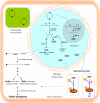Viroid pathogenicity: one process, many faces
- PMID: 21994551
- PMCID: PMC3185495
- DOI: 10.3390/v1020298
Viroid pathogenicity: one process, many faces
Abstract
Despite the non-coding nature of their small RNA genomes, the visible symptoms of viroid infection resemble those associated with many plant virus diseases. Recent evidence indicates that viroid-derived small RNAs acting through host RNA silencing pathways play a key role in viroid pathogenicity. Host responses to viroid infection are complex, involving signaling cascades containing host-encoded protein kinases and crosstalk between hormonal and defense-signaling pathways. Studies of viroid-host interaction in the context of entire biochemical or developmental pathways are just beginning, and many working hypotheses have yet to be critically tested.
Keywords: RNA silencing; disease induction; viroid pathogenicity.
Figures



Similar articles
-
Current overview on viroid-host interactions.Wiley Interdiscip Rev RNA. 2020 Mar;11(2):e1570. doi: 10.1002/wrna.1570. Epub 2019 Oct 22. Wiley Interdiscip Rev RNA. 2020. PMID: 31642206 Review.
-
Comprehensive Transcriptome Analyses Reveal that Potato Spindle Tuber Viroid Triggers Genome-Wide Changes in Alternative Splicing, Inducible trans-Acting Activity of Phased Secondary Small Interfering RNAs, and Immune Responses.J Virol. 2017 May 12;91(11):e00247-17. doi: 10.1128/JVI.00247-17. Print 2017 Jun 1. J Virol. 2017. PMID: 28331096 Free PMC article.
-
Virus and Viroid-Derived Small RNAs as Modulators of Host Gene Expression: Molecular Insights Into Pathogenesis.Front Microbiol. 2021 Jan 14;11:614231. doi: 10.3389/fmicb.2020.614231. eCollection 2020. Front Microbiol. 2021. PMID: 33584579 Free PMC article. Review.
-
Specific argonautes selectively bind small RNAs derived from potato spindle tuber viroid and attenuate viroid accumulation in vivo.J Virol. 2014 Oct;88(20):11933-45. doi: 10.1128/JVI.01404-14. Epub 2014 Aug 6. J Virol. 2014. PMID: 25100851 Free PMC article.
-
A pathogenic non-coding RNA induces changes in dynamic DNA methylation of ribosomal RNA genes in host plants.Nucleic Acids Res. 2014 Feb;42(3):1553-62. doi: 10.1093/nar/gkt968. Epub 2013 Oct 30. Nucleic Acids Res. 2014. PMID: 24178032 Free PMC article.
Cited by
-
Discovery of replicating circular RNAs by RNA-seq and computational algorithms.PLoS Pathog. 2014 Dec 11;10(12):e1004553. doi: 10.1371/journal.ppat.1004553. eCollection 2014 Dec. PLoS Pathog. 2014. PMID: 25503469 Free PMC article.
-
An Inside Look into Biological Miniatures: Molecular Mechanisms of Viroids.Int J Mol Sci. 2021 Mar 10;22(6):2795. doi: 10.3390/ijms22062795. Int J Mol Sci. 2021. PMID: 33801996 Free PMC article. Review.
-
Dissecting the role of bHLH transcription factors in the potato spindle tuber viroid (PSTVd)-tomato pathosystem using network approaches.PLoS One. 2025 May 7;20(5):e0318573. doi: 10.1371/journal.pone.0318573. eCollection 2025. PLoS One. 2025. PMID: 40334007 Free PMC article.
-
Viroids as a Tool to Study RNA-Directed DNA Methylation in Plants.Cells. 2021 May 13;10(5):1187. doi: 10.3390/cells10051187. Cells. 2021. PMID: 34067940 Free PMC article. Review.
-
Microarray analysis of Etrog citron (Citrus medica L.) reveals changes in chloroplast, cell wall, peroxidase and symporter activities in response to viroid infection.Mol Plant Pathol. 2012 Oct;13(8):852-64. doi: 10.1111/j.1364-3703.2012.00794.x. Epub 2012 Mar 15. Mol Plant Pathol. 2012. PMID: 22420919 Free PMC article.
References
-
- Diener TO. Potato spindle tuber “virus” IV. A replicating, low molecular weight RNA. Virology. 1971;45:411–428. - PubMed
-
- Gross HJ, Domdey H, Lossow C, Jank P, Raba M, Alberty H, Sänger H-L. Nucleotide sequence and secondary structure of potato spindle tuber viroid. Nature. 1978;273:203–208. - PubMed
-
- Dickson E, Robertson HD, Niblett CL, Horst RK, Zaitlin M. Minor differences between nucleotide sequences of mild and severe strains of potato spindle tuber viroid. Nature. 1979;277:60–62.
LinkOut - more resources
Full Text Sources

